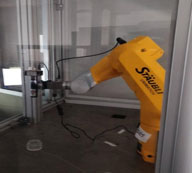Europ platform
The EUROP platform recreates the entire network architecture (ADSL, fiber optics, etc.) and services (Internet access, telephone, TV) of a major telecom operator (such as Orange, Bouygues, SFR, Free, etc.) in a single room.
EUROP is made up of physical equipment from the collection network (Internet box, DSLAM, etc.), which uses either the old copper cabling of our telephone lines (ADSL, ADSL2+, SHDSL, VDSL2), or the fiber optic cabling currently being deployed (GPON or point-to-point), then via the core network (MPLS routers) to finally arrive at the datacenter equipment (virtualization servers, hyperconvergence). EUROP is both a tool for our partner companies and a training tool for our students. Projects with companies are in the fields of operator networks, optical technologies (point-to-point and GPON) and the Internet of Things. EUROP can recreate the complete chain of an operator network, enabling companies to come and test their materials, services or equipment by simulating the data path from a low-speed end customer (such as a private individual in the countryside) to a fast professional connection (corporate optical fiber in a city center).Another example is Internet of Things (IoT) projects. Hardware or software is installed on the EUROP platform, which supports LoRaWAN technology (the most popular long-range wireless technology for IoT), and objects can connect and send data to the Internet.
From a pedagogical point of view, the EUROP platform enables our students to implement all the hardware and software building blocks of an Internet operator, from access for private individuals or companies, to the configuration of end services such as IP telephony or TV broadcasting, via the security and quality of service of the core network (MPLS, etc.). The latter also gives them a practical understanding of cloud computing and virtualization technologies used in data centers. It also includes practical work on IoT.
EUROP is also used for student and research projects on smart cities, IoT and innovative technologies (in-network computing, P4 language, etc.).
Download the poster
Image Platform
Composition
A robot cell with a Staübli 6-axis robot. A camera is fixed to the top of the robot, enabling it to locate objects by calculating their centers of gravity, for example. This information is transmitted to the robot, which picks up and moves the objects. These “pick and place” operations enable objects to be sorted according to criteria calculated by image processing.
An assembly consisting of a conveyor belt, a 3 ccd linear camera and a pneumatic solenoid valve ejection system. This station is used to develop dynamic shape and color sorting algorithms.
A set of 2 conveyors and 1 robot. This assembly is currently being rebuilt. It contains all the elements present on a production line: presence sensors to trigger image acquisition, mechanical ejection system, safety sensors. These tools are used to simulate the automation of a production line: quality control with robot sorting. Samples are placed on the starting conveyor, routed under the acquisition station and then, based on the verdict indicated by the image processing, the objects are positioned or not on the reject conveyor.

Teaching
This platform is used in the Image & Photonics, Smart-Industries apprenticeship program.For2nd year students: “Robotics” module
The aim of this module is to provide second-year students with an overview of technological developments in robotics, and the associated challenges. At the end of this course, apprentices will have a general overview of these techniques and their associated advantages, in both industrial and service contexts.
For3rd year students: “Robotics application” module
The aim of this module is to present methods for applying image analysis and processing tools to robotics. At the end of this course, apprentices will be able to use the results of an image processing test to pilot a robot in an industrial context. For example, sorting parts by shape and color.
Optical Platform
Télécom Saint-Etienne offers a total of more than thirty optics-photonics experiments for students and apprentices at the school, including :
Manipulations in :
– Geometrical optics (focometry, telescope, microscope, goniometer, etc.),
– Wave optics and Fourier optics (Michelson interferometer, bi-prism, Young’s slit device, optical image processing, optical holography, etc.).)
– Guided/integrated optics (fiber characterization, audio signal transmission by optical fiber, wavelength division multiplexing, simulation of classical integrated optics structures…)
– Polarized light (liquid crystal display, birefringent plate, 3D cinema…)
– Photonics (study of laser systems : laser diode, Nd:YAG laser, He-Ne laser, beam cleaning, M² measurement…)
– Photometry (spectral characterization of sources, secondary sources, study of Bouguer’s law…)
Instruments or study benches:
– Phase contrast microscope,
– Fringe projection profilometer,
– Shack-Hartmann spatial phase modulator-wavefront analyzer
– UV/visible spectrometer
– Bragg grating fiber optic sensor
We also have :
An optical holography room for recording and developing holograms on transmission and reflection holographic plates. A classroom dedicated to practical courses, with 7 identical workbenches to illustrate a wide range of geometric and wave optics concepts presented by the teacher and reproduced in real time by the students. A marking laser for marking (identification number, data matrix, logo, etc.) on a wide range of materials.
Each year, we offer projects combining optics-photonics with other school themes such as image, vision, electronics, computer science, etc., which enable us to implement technical solutions or set up specific instrumentation benches. These projects include: laser microphones, air flow interferometry, roughness measurement using speckle interferometry, 3D laser triangulation, etc.